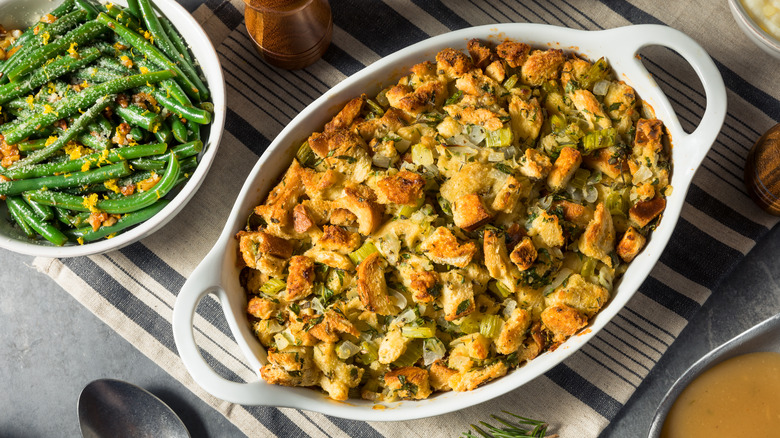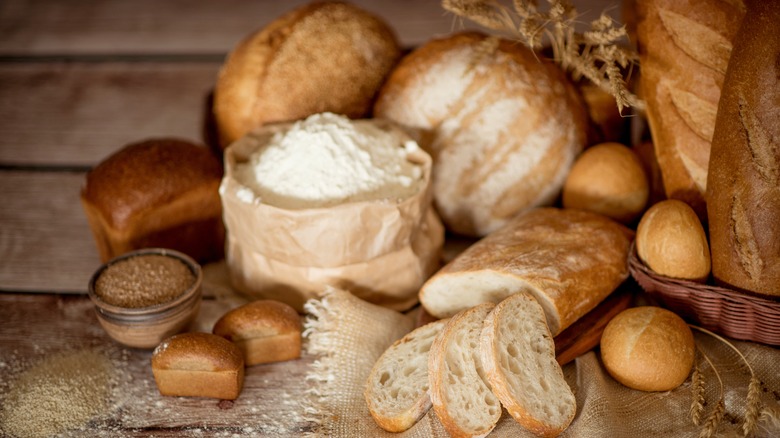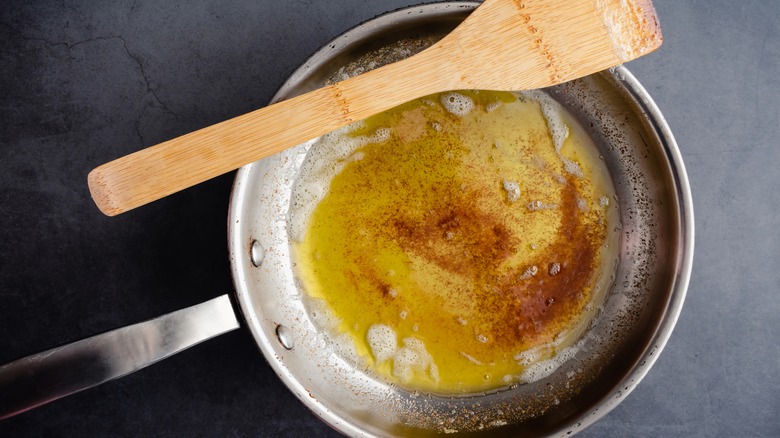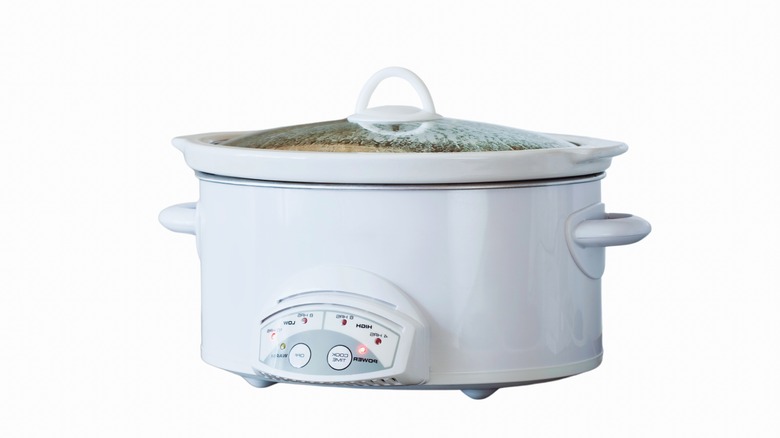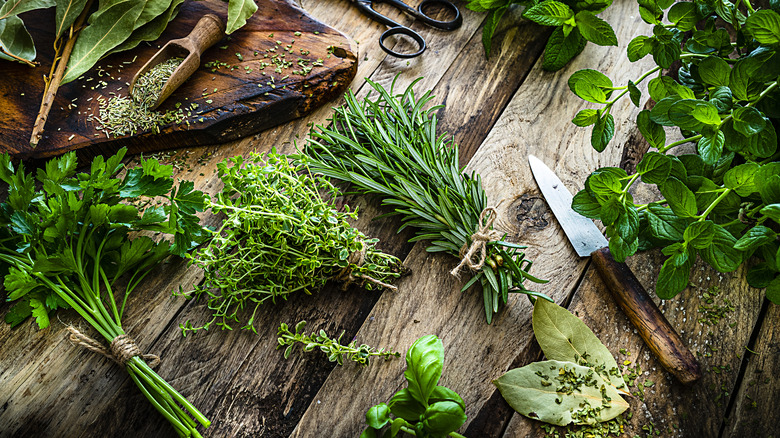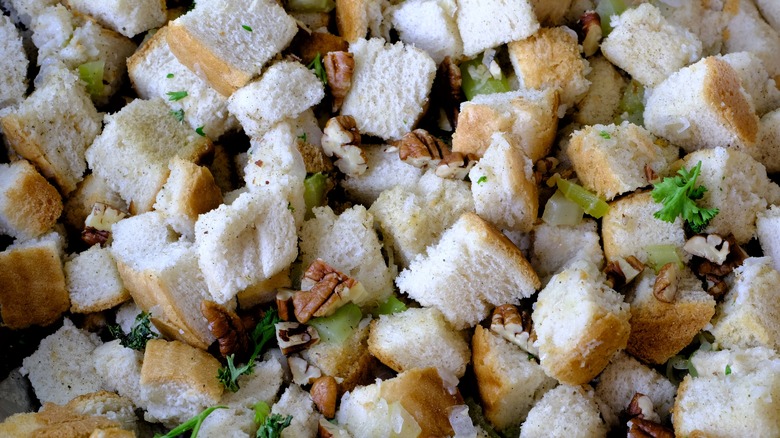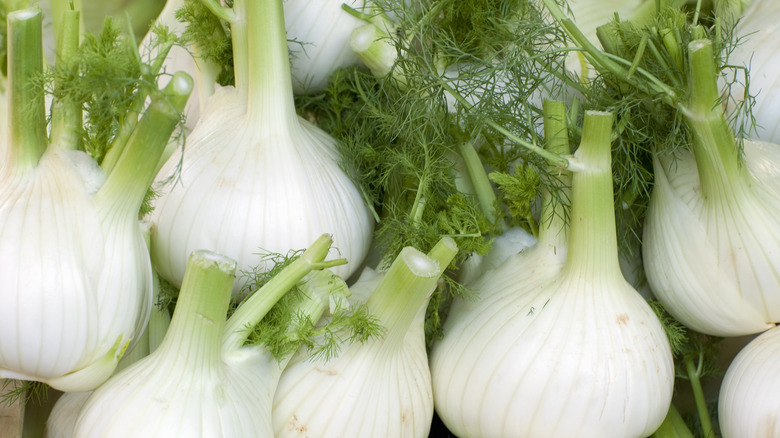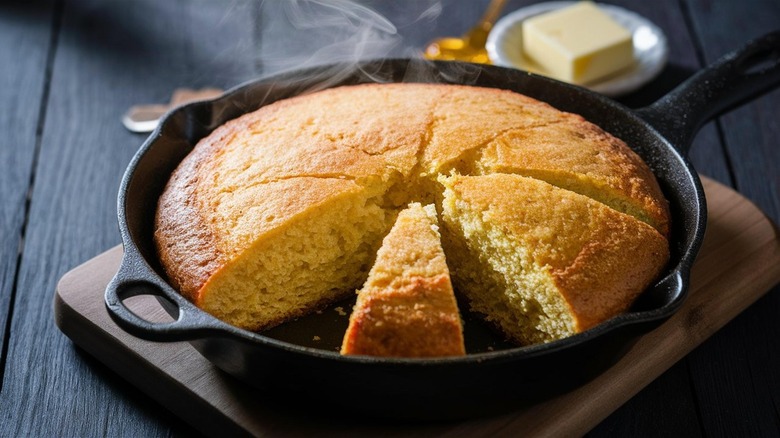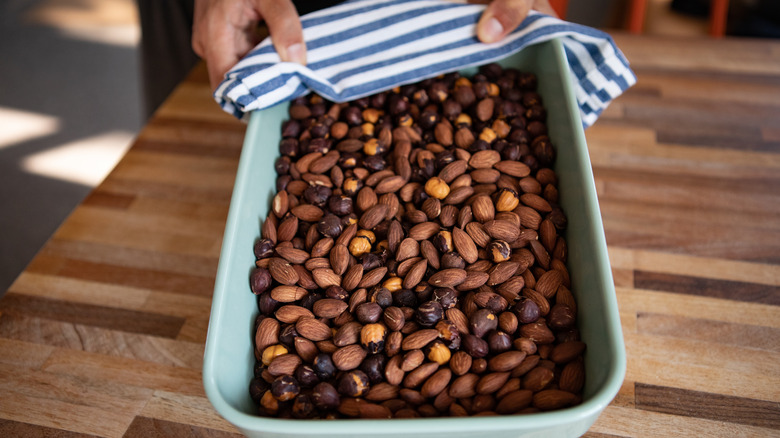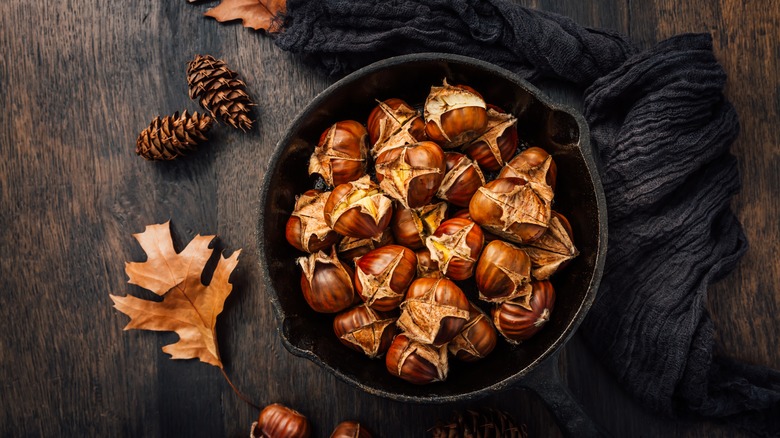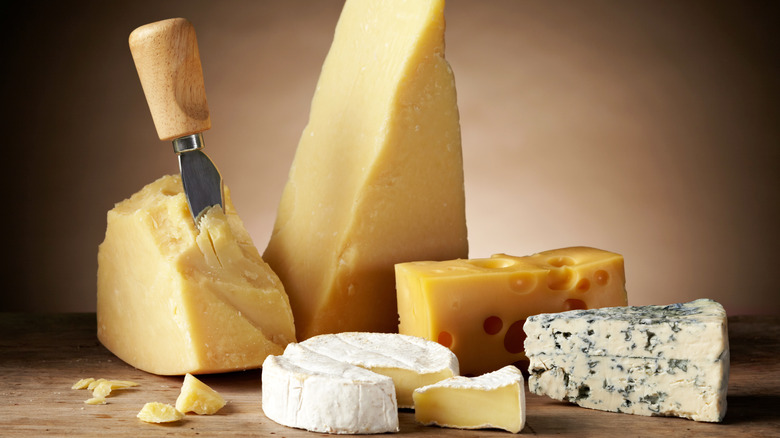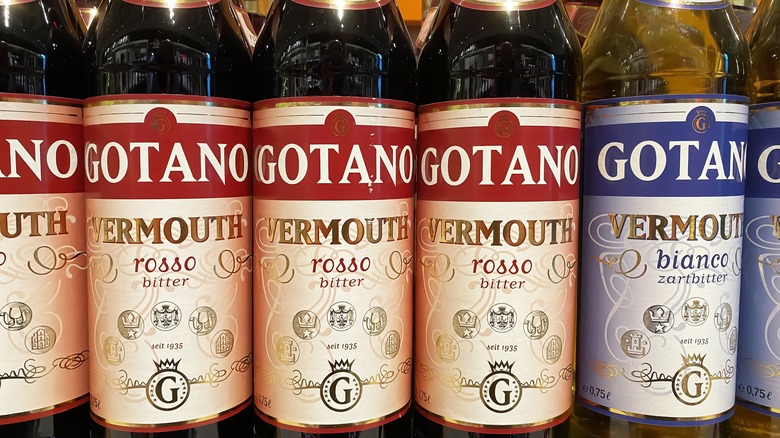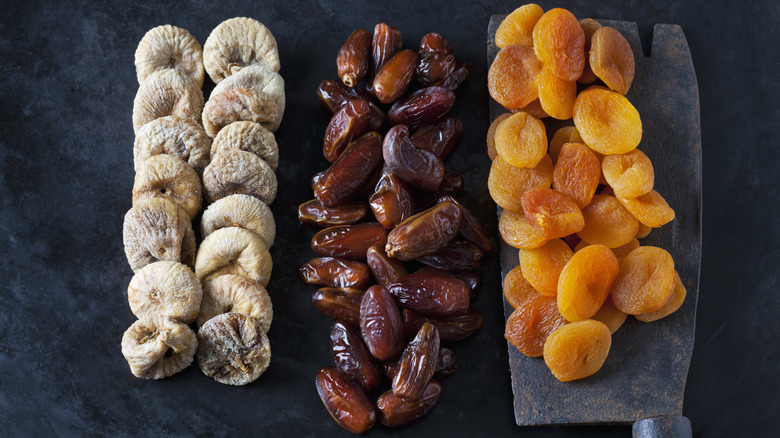13 Ways To Upgrade Homemade Stuffing
Sure, it's tempting to reach for a boxed stuffing mix, but making this holiday classic from scratch can pay off. That said, some recipes are quite boring and will leave you wishing you'd saved time and just used the packaged stuff. However, we know some ways to upgrade homemade stuffing that are totally worth it. This dish is never going to be the main attraction, but it can be surprisingly tasty.
There are plenty of Thanksgiving stuffing hacks out there, but we want to focus on quality upgrades rather than quick fixes. We're not saying that you should devote too much time to stuffing. After all, if you're making it as part of a holiday feast, you have enough on your plate. However, spending a few extra minutes here and there can take your homemade stuffing from just fine to brilliant.
Whether you decide to look beyond basic white sliced bread, use aromatics, or add toasted nuts for texture, your homemade stuffing will be the side everyone is reaching for. You can use just one of these techniques to level up your go-to recipe or combine a few to make it even more delicious. Either way, you'll never have realized how good homemade stuffing can be until now.
Look beyond basic sliced bread
Sliced white bread may be a convenient choice for homemade stuffing, but it's little more than a vehicle for seasoning. Beneath the crisp surface of the stuffing, the moisture causes it to dissolve and clump together. Although some people like its custardy texture, it can end up stodgy and one-note. A thoughtful choice of bread, however, transforms stuffing into something with more dimension to it. It plays with texture, taste, aroma, and can even riff off a range of food cultures.
You might want to consider a dense sourdough. Its tang lends depth to the herbs and aromatics, while its hearty crust provides pockets of chew and crisp edges. Costco shoppers are obsessed with a packaged sourdough stuffing, so homemade can only be better. A dense rye bread works surprisingly well. It pairs beautifully with earthy mushrooms and a touch of thyme. Or, if you like the softness of sliced white but want to upgrade, rich, slightly sweet brioche or challah work well.
You need to understand both the flavor and structure that your chosen bread will bring. Bread with a sturdy crumb absorbs liquid without collapsing, giving you that perfectly moist interior and crispy top.
Use brown butter
Most stuffing recipes contain butter. A simple upgrade is to use brown butter in its place. This adds extra flavor with its toasty, nutty notes coming through. You need to start using brown butter in your recipes, and this is a great place to begin.
To make it, start with unsalted butter in a light-colored pan so you can watch its transformation. Over medium heat, the butter foams and then clarifies, the water evaporating as the solids sink to the bottom. Stir or swirl the pan gently. You'll see the pale specks deepen to amber and notice a toasted fragrance. Pull it from the heat just before it's ready, as the residual warmth helps finish it off perfectly. Then, you can drizzle it over the bread in your recipe, add it in with the other wet ingredients, or use it like-for-like in a recipe that calls for melted butter.
In stuffing, brown butter goes a long way, adding depth of flavor that comes from the Maillard reaction. Even if you don't know it by name, you're probably a fan of its work. It's what makes toast taste different to bread or makes dark roast coffee beans richer than light roast. Brown butter pairs especially well with umami flavors, like sautéed mushrooms or aged cheeses.
Try using the slow cooker for a better texture
Sometimes, upgrading a recipe isn't about changing the ingredients but the way you cook them. For the ultimate Thanksgiving stuffing, you should crack out your slow cooker. This might seem strange at first — after all, aren't slow cookers for more liquid-forward recipes like soups and stews? However, once you get past that, you'll see that it's actually a solid recipe.
Slow cookers concentrate their heat at the bottom of the appliance and around the outside of the cooking pot. Unlike ovens, they don't have a heating element up top. This means that, once the stuffing is done, it won't look how you'd expect it to. It will basically look like a lump of steamed bread, which doesn't sound all that appetizing. However, once you turn it out, the bottom and sides will be nicely browned and crisp. Serve it upside down and you'll have a perfectly crisp exterior and a moist interior.
You can adapt your favorite homemade stuffing recipe to work in the slow cooker. All you need to do is cut back the liquid in the recipe by a ¼, butter the outside of the cooking pot to stop it sticking, and cook on low for four to six hours. Plus, if the recipe doesn't contain eggs, add 1 ½ eggs for every loaf of bread you use.
Use more fresh herbs
Stuffing recipes sometimes include fresh herbs — but not enough. You might find a cursory couple of fresh sage leaves in a recipe, but more often than not, dried herbs are the default. However, you can make your homemade stuffing even tastier by increasing the quantity of fresh herbs you use.
It's pretty much impossible to use too many fresh herbs without it obviously looking like too many. You can even add a couple of full bunches of herbs without going overboard. Yes, the finished dish will be intensely herby, but in a good way. That said, you should think about how much you use of which herb, as some are more potent than others. For instance, you could use a full bunch of parsley with no problems, but a huge bunch of thyme might be too much.
While you can use any herbs in your stuffing, some work better with the classic flavors of the holiday meal than others. For instance, sage, rosemary, and thyme are all classic fall flavors. Parsley is a little fresher and lighter but still works well with these kinds of flavors. Marjoram is not as commonly found fresh in grocery stores, but has a woody sweetness that's great in stuffing. Lovage is another lesser-used herb that's a delicious choice, with aromatic celery notes. Both coriander and basil don't necessarily go well with stuffing and can overwhelm other flavors — but we're all about experimenting with food.
Make sure to dry out your bread
Many stuffing recipes make reference to stale bread, but who really pays attention to that? And what does it even mean? It can be unclear whether it should be rock hard or just a tiny bit less than fresh. This often leads people to just use whatever bread they have on hand, fresh or not. But, a simple way to make your homemade stuffing even better is to dry the bread out. This way, you get the correct texture without any potential unpleasant flavor that comes with old bread.
It might seem basic, but Martha Stewart's tip for the best Thanksgiving stuffing is simply to dry out your bread. To do so, you cut or tear your bread into small pieces and put them in the oven on low. Stewart prefers tearing for a more rustic look. This low and slow baking technique removes the moisture without burning or toasting the bread. Then, when you come to make your stuffing, the bread will absorb the liquid without going soggy. This is how you get crisp yet tender stuffing. It's a simple technique for improving this dish, which you can combine with some of the more flavorful upgrades to make this holiday side even more special.
Add fennel
Fennel is one of those ingredients that can completely transform homemade stuffing, adding unexpected notes that still manage to be subtle. Its natural sweetness and mild anise-like flavor bring a brightness that complements the other ingredients. If you've only ever used onions and celery as your aromatic base, adding fennel is a twist you need to try. It can elevate this classic dish, making it taste more sophisticated.
To incorporate it, slice the fennel bulb thinly and sauté it with your other aromatics. Add fennel — plus any other ingredients like onion or celery that you're using — to a pan with oil or butter and cook it until it softens and develops some color. The heat draws out fennel's natural sugars, mellowing its sharpness. This leaves it with a gentle sweetness that enhances the stuffing without overpowering it.
What fennel does best is provide contrast. It cuts through the richness of butter and stock, balancing heavier flavors with its freshness. Pair fennel with classic stuffing herbs like sage, thyme, and rosemary to make the dish even tastier. It manages to meld in with the other flavors, feeling entirely at home. It gives homemade stuffing an edge that's hard to pinpoint but impossible to forget.
Use homemade cornbread
Cornbread stuffing has a certain charm that bread-based versions often can't match. Its crumbly texture soaks up the liquid in any recipe beautifully while holding its shape, creating a dish that feels hearty without being dense. But to make truly incredible stuffing, you need to make the cornbread yourself. This is a next-level upgrade that takes a bit of time but will give you incredible results. Let us tell you why you should bake your own cornbread for stuffing.
Store-bought cornbread often leans too sweet, its sugary undertones clashing with the savory ingredients. Homemade versions give you control, allowing you to omit the sugar entirely or dial it back to a subtle hint that complements rather than competes. The result is a more balanced base — one that absorbs the flavors of aromatics, broth, and herbs without feeling out of place.
There's also the difference in flavor. Homemade cornbread just tastes better than store-bought. There's no getting around it. You can taste the richness of real butter, the earthiness of stone-ground cornmeal, and the slight tang from buttermilk. All of this will bring complexity to your stuffing. Plus, its texture is superior. It's sturdier, with a coarse crumb that stands up to the moisture in the dish.
Toast some nuts
Adding toasted nuts is a simple way to transform homemade stuffing. They bring texture and, of course, their tasty nutty flavor. Their crunch adds contrast to a dish that can be texturally one-note. Whether you choose pecans, walnuts, hazelnuts, or even pine nuts, you need to know how to toast them.
Luckily, you have options. The stovetop method is quick and convenient: scatter the nuts in a dry skillet over medium heat, stirring frequently to prevent scorching. You'll know they're ready when they smell nuttier and their color turns golden. For larger batches, the oven can be simpler. Spread the nuts on a baking sheet and toast them at 325 degrees Fahrenheit for 10 to 15 minutes, shaking the pan occasionally for even browning. You should watch them closely, though — nuts can go from perfectly golden to burnt in the blink of an eye.
Whichever method you choose, when they're done, just mix them in with your other stuffing ingredients and cook them as normal. It's better if they're layered under the bread, otherwise they might burn from the heat of the oven.
Add chestnuts
Chestnuts are the ultimate holiday addition to stuffing. Although they're often only used around the festive season, they're good enough that they should be enjoyed year-round. Their flavor is nutty yet mild, with an almost creamy interior that blends in well with the moist bread. Whether you chop them or leave them in larger chunks, chestnuts add a richness that complements the other ingredients in homemade stuffing.
Pre-roasted, shelled chestnuts, often sold in vacuum-sealed packets, are a great time-saver if you can find them. They're ready to use and require little preparation — just a quick chop before folding them into the mix. But you can't always rely on finding them. Plus, roasting your own chestnuts can be worth the effort, both for freshness and flavor.
To roast chestnuts, score the shells with an "X" to prevent them from bursting, then bake them at 400 degrees Fahrenheit until the shells curl back and the interiors soften. Once they're cool enough to handle, peel away the tough outer layer. They're now ready to use in your stuffing — assuming you don't end up eating them all before they find their way into your recipe.
Use beer in place of some of the stock
Replacing some or all of the broth in stuffing with beer introduces a depth of flavor that transforms the dish. Beer's malty sweetness and bitter edge bring a complexity that broth alone can't match. It elevates even the most traditional recipes. But the type of beer you choose matters, as each style contributes its own personality.
A nutty brown ale adds warmth and subtle caramel undertones, perfect for stuffing that leans on herbs like sage and thyme. If you're looking for something brighter, a crisp lager or wheat beer is a good choice. It enhances the aromatics without overpowering them.
For heartier stuffing, consider a stout or porter. These dark beers have a roasted, almost chocolatey depth that pairs well with mushrooms or chestnuts. The bold flavor can hold its own alongside strong seasonings like garlic or rosemary. And if you're feeling adventurous, a hoppy IPA introduces fruity or floral notes that give a modern twist to a classic dish.
When using beer, simmer it briefly with the aromatics to mellow any bitterness before incorporating it into the stuffing. This lets the alcohol cook off a bit and gives the dish a more balanced flavor. If you replace stock with beer, make sure to add extra salt to replace what you've left out.
Make it cheesy
Few dishes can't be improved with the liberal application of cheese — and stuffing is no exception. It makes this side more decadent and even more of a crowd-pleaser. And the best thing, it's extremely easy to pull off.
All you need to do is add around a cup of shredded or crumbled cheese to your usual stuffing recipe. Mix around ⅔ of that in with the other ingredients and sprinkle the remaining ⅓ on top, before it goes in the oven. This gives you a melty topping that might brown or crisp in parts, adding to the deliciousness.
Cheese works well with beer stuffing, and it also tastes great with loads of herbs — the choice of cheese is up to you. Cheddar is a classic that's sure to satisfy most guests at the dinner table. You could also go for a milder, creamier option, like Edam or Gouda. Alternatively, you might go in the other direction and opt for something more robust, like a complex blue cheese or an intense salty feta. Whatever cheese you settle on, it's sure to impress.
Add some vermouth
It might seem a little old fashioned, but dry vermouth is a great addition to homemade stuffing. With its herbal undertones and crisp acidity, it enhances this classic dish without overwhelming it. Vermouth is fortified, so it lasts longer than wine once open — several months in the fridge. This makes it a practical choice for holiday cooking since you can use it throughout the festive season without worrying that it will spoil.
To use dry vermouth in stuffing, add a splash to the pan once your aromatics have softened in butter or oil. The heat will cook off the alcohol, mellowing its flavor so it isn't too boozy. The light bitterness of vermouth pairs well with traditional herbs like sage, thyme, and parsley. So, you can load up on herbs and add vermouth to make your stuffing stand out. It also works well with the anise-like flavor of fennel. Vermouth is versatile enough to elevate various stuffing styles, so you can use your favorite recipe and just splash in a bit of this alcohol to mix things up.
Mix in some dried fruit
Dried fruit can make a delicious addition to a basic stuffing. It adds a sweetness that contrasts the savory ingredients. If you're a fan of the sweet and salty combo, this is a must. Dried fruit also provides some textural contrast to the rest of the ingredients and bursts of flavor.
But, what dried fruit should you use? Cranberries are an obvious choice if you're making stuffing for the holidays. They're sweet yet tart and work amazingly in savory dishes. However, other dried fruit also works great here. Apricots, cherries, semi-dried apples, dates, and even just basic old raisins are good choices. Mix them in with your other ingredients so they're evenly distributed through the dish.
When you add dried fruit to stuffing, you might also want to add some sweet spices to complement the fruit. Cinnamon, nutmeg, cloves, and allspice are all great choices. Don't be too heavy-handed with them. Just add a little pinch to bring a festive twist to the recipe without bringing these flavors to the forefront. Stuffing with dried fruit also needs plenty of savory notes to balance it out. Make sure you don't skimp on onions and other aromatics and maybe add some more umami ingredients, like sautéed mushrooms.
